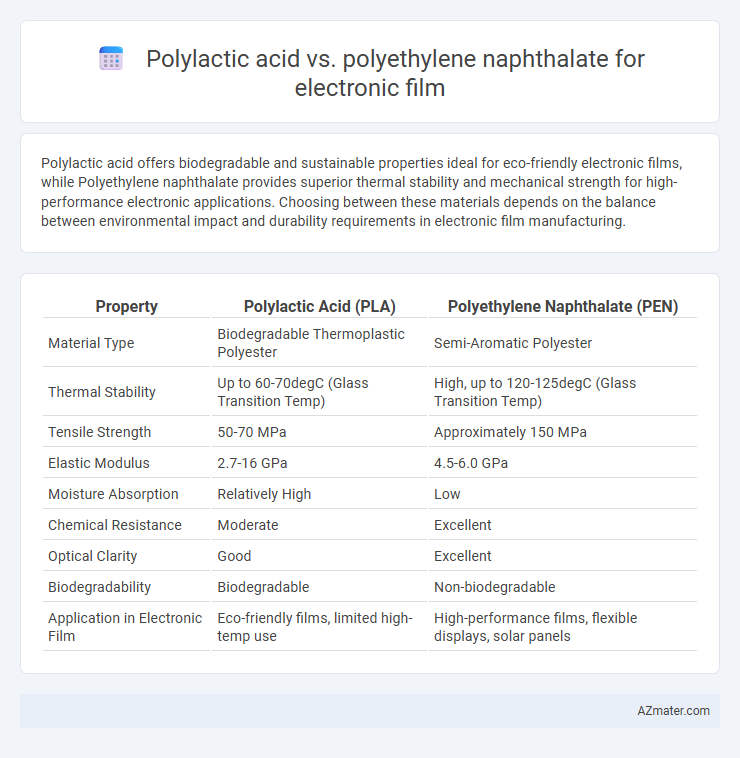Polylactic acid offers biodegradable and sustainable properties ideal for eco-friendly electronic films, while Polyethylene naphthalate provides superior thermal stability and mechanical strength for high-performance electronic applications. Choosing between these materials depends on the balance between environmental impact and durability requirements in electronic film manufacturing.
Table of Comparison
| Property | Polylactic Acid (PLA) | Polyethylene Naphthalate (PEN) |
|---|---|---|
| Material Type | Biodegradable Thermoplastic Polyester | Semi-Aromatic Polyester |
| Thermal Stability | Up to 60-70degC (Glass Transition Temp) | High, up to 120-125degC (Glass Transition Temp) |
| Tensile Strength | 50-70 MPa | Approximately 150 MPa |
| Elastic Modulus | 2.7-16 GPa | 4.5-6.0 GPa |
| Moisture Absorption | Relatively High | Low |
| Chemical Resistance | Moderate | Excellent |
| Optical Clarity | Good | Excellent |
| Biodegradability | Biodegradable | Non-biodegradable |
| Application in Electronic Film | Eco-friendly films, limited high-temp use | High-performance films, flexible displays, solar panels |
Introduction to Electronic Film Materials
Polylactic acid (PLA) and Polyethylene naphthalate (PEN) are prominent materials for electronic film applications, each offering distinct properties. PLA, a biodegradable polymer derived from renewable resources, provides excellent transparency and rigidity but has limited thermal stability. PEN, a high-performance aromatic polyester, exhibits superior thermal resistance, mechanical strength, and dimensional stability, making it ideal for flexible display substrates and printed electronics.
Overview of Polylactic Acid (PLA)
Polylactic Acid (PLA) is a biodegradable thermoplastic derived from renewable resources like corn starch or sugarcane, widely used in packaging and electronic films due to its eco-friendly properties and good mechanical strength. PLA offers high transparency, excellent dimensional stability, and a relatively low melting point around 170-180degC, making it suitable for sustainable electronic film applications requiring flexibility and clarity. Compared to Polyethylene Naphthalate (PEN), PLA's biodegradability and lower environmental impact are significant advantages, though PLA typically exhibits lower thermal resistance and barrier performance.
Overview of Polyethylene Naphthalate (PEN)
Polyethylene naphthalate (PEN) is a high-performance polyester known for its superior thermal stability, excellent mechanical strength, and exceptional barrier properties, making it well-suited for electronic film applications. PEN exhibits higher glass transition temperature (around 120degC) and better chemical resistance compared to conventional polyesters, contributing to enhanced durability in flexible electronics. Its dimensional stability and low moisture absorption also ensure reliable performance in demanding environments, distinguishing it from polylactic acid (PLA) which has lower thermal resistance and mechanical robustness.
Mechanical Properties: PLA vs PEN
Polylactic acid (PLA) exhibits lower tensile strength and modulus compared to Polyethylene naphthalate (PEN), making PEN superior for high-stress applications in electronic films. PEN offers excellent dimensional stability and higher impact resistance, crucial for flexible and durable electronic components. The enhanced mechanical properties of PEN, including better heat resistance and toughness, make it a preferred choice over PLA in demanding electronic film applications.
Thermal Stability Comparison
Polylactic acid (PLA) exhibits lower thermal stability with a decomposition temperature around 280degC, making it less suitable for high-temperature electronic film applications compared to Polyethylene naphthalate (PEN). PEN demonstrates superior thermal resistance, with a glass transition temperature near 120degC and melting point exceeding 270degC, ensuring enhanced dimensional stability and durability under prolonged heat exposure. The high thermal stability of PEN contributes to its widespread use in flexible electronic displays and insulation films where heat resistance is critical.
Electrical Performance for Electronic Applications
Polylactic acid (PLA) exhibits excellent dielectric properties with a high breakdown voltage and low dielectric constant, making it suitable for flexible electronic films requiring biodegradability. Polyethylene naphthalate (PEN) offers superior electrical insulation, thermal stability, and low moisture absorption, which enhances long-term reliability in high-frequency electronic applications. PEN's higher glass transition temperature and robust electrical performance provide a key advantage over PLA in demanding electronic environments.
Barrier Properties and Moisture Resistance
Polylactic acid (PLA) exhibits moderate barrier properties with limited moisture resistance, making it less effective for electronic film applications requiring high protection against water vapor and oxygen permeation. Polyethylene naphthalate (PEN) demonstrates superior barrier performance due to its dense molecular structure, significantly reducing moisture transmission and enhancing the durability of electronic films. PEN's enhanced thermal stability also contributes to maintaining barrier integrity under varying environmental conditions, outperforming PLA in electronic film encapsulation.
Environmental Impact and Sustainability
Polylactic acid (PLA) offers a biodegradable and compostable alternative to conventional plastics, significantly reducing long-term environmental pollution compared to Polyethylene naphthalate (PEN), which is derived from petrochemicals and is non-biodegradable. While PEN provides superior thermal stability and mechanical strength ideal for electronic film applications, its lifecycle environmental impact includes fossil fuel dependency and challenges in recycling. Choosing PLA enhances sustainability by leveraging renewable biomass sources, minimizing carbon footprint, and facilitating end-of-life compostability, making it a preferred option for eco-friendly electronic films.
Cost and Manufacturing Considerations
Polylactic acid (PLA) offers a biodegradable alternative with lower raw material costs compared to Polyethylene naphthalate (PEN), but its processing temperatures are typically lower, impacting thermal stability during electronic film manufacturing. PEN provides superior chemical resistance and mechanical strength, justifying its higher production costs owing to more energy-intensive synthesis and longer cycle times. Manufacturing with PEN requires precise thermal management and barrier properties optimization, whereas PLA demands careful control of moisture sensitivity and crystallinity for consistent film performance in electronic applications.
Application Suitability: Choosing Between PLA and PEN
Polyethylene naphthalate (PEN) offers superior thermal stability, chemical resistance, and dimensional stability, making it more suitable for high-performance electronic films used in flexible displays and advanced circuit substrates. Polylactic acid (PLA), while biodegradable and environmentally friendly, lacks the mechanical robustness and heat resistance required for demanding electronic applications, limiting its use to lower-performance or short-lifespan devices. Selecting between PLA and PEN depends on prioritizing durability and thermal endurance for PEN or sustainability and biodegradability for PLA in electronic film applications.

Infographic: Polylactic acid vs Polyethylene naphthalate for Electronic Film
 azmater.com
azmater.com